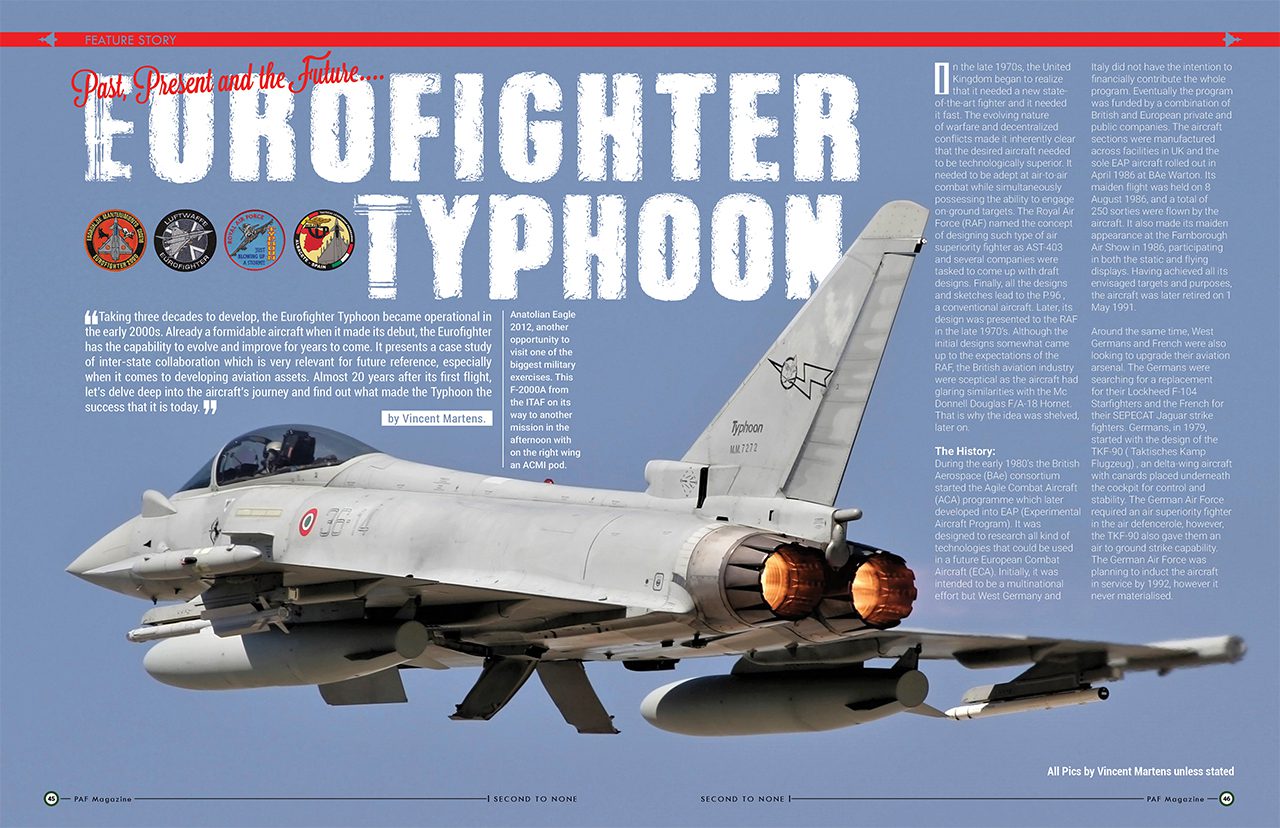Taking three decades to develop, the Eurofighter Typhoon became operational in the early 2000s. Already a formidable aircraft when it made its debut, the Eurofighter has the capability to evolve and improve for years to come. It presents a case study of inter-state collaboration which is very relevant for future reference, especially when it comes to developing aviation assets. Almost 20 years after its first flight, let’s delve deep into the aircraft’s journey and find out what made the Typhoon the success that it is today.
In the late 1970s, the United Kingdom began to realize that it needed a new state-of-the-art fighter and it needed it fast. The evolving nature of warfare and decentralized conflicts made it inherently clear that the desired aircraft needed to be technologically superior. It needed to be adept at air-to-air combat while simultaneously possessing the ability to engage on-ground targets. The Royal Air Force (RAF) named the concept of designing such type of air superiority fighter as AST-403 and several companies were tasked to come up with draft designs. Finally, all the designs and sketches lead to the P.96 , a conventional aircraft. Later, its design was presented to the RAF in the late 1970’s. Although the initial designs somewhat came up to the expectations of the RAF, the British aviation industry were sceptical as the aircraft had glaring similarities with the Mc Donnell Douglas F/A-18 Hornet. That is why the idea was shelved, later on.
The History:
During the early 1980’s the British Aerospace (BAe) consortium started the Agile Combat Aircraft (ACA) programme which later developed into EAP (Experimental Aircraft Program). It was designed to research all kind of technologies that could be used in a future European Combat Aircraft (ECA). Initially, it was intended to be a multinational effort but West Germany and Italy did not have the intention to financially contribute the whole program. Eventually the program was funded by a combination of British and European private and public companies. The aircraft sections were manufactured across facilities in UK and the sole EAP aircraft rolled out in April 1986 at BAe Warton. Its maiden flight was held on 8 August 1986, and a total of 250 sorties were flown by the aircraft. It also made its maiden appearance at the Farnborough Air Show in 1986, participating in both the static and flying displays. Having achieved all its envisaged targets and purposes, the aircraft was later retired on 1 May 1991.
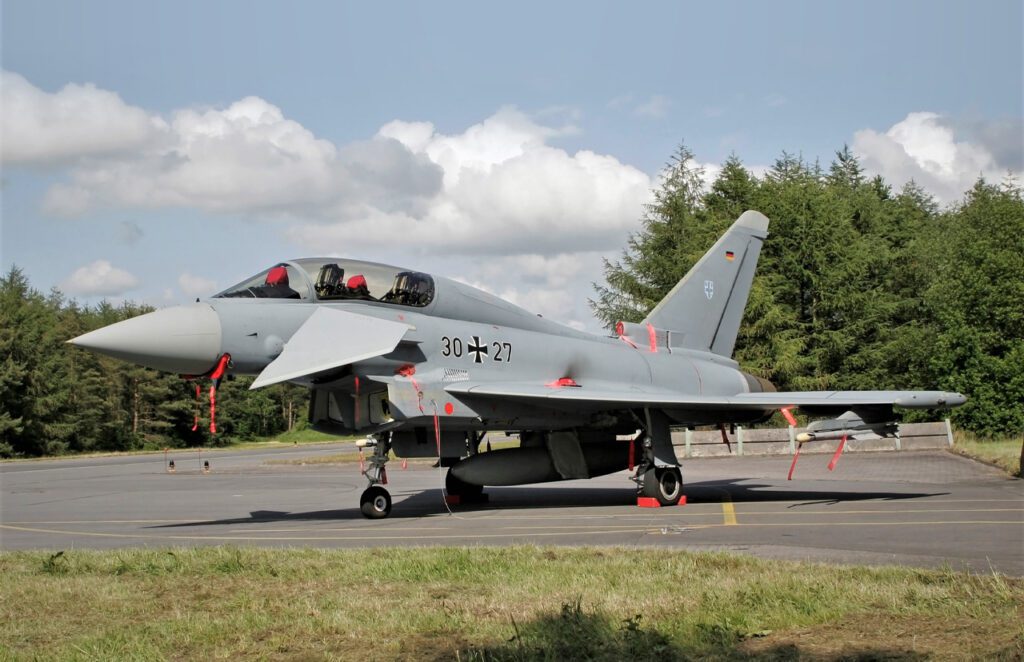
Around the same time, West Germans and French were also looking to upgrade their aviation arsenal. The Germans were searching for a replacement for their Lockheed F-104 Starfighters and the French for their SEPECAT Jaguar strike fighters. Germans, in 1979, started with the design of the TKF-90 ( Taktisches Kamp Flugzeug) , an delta-wing aircraft with canards placed underneath the cockpit for control and stability. The German Air Force required an air superiority fighter in the air defencerole, however, the TKF-90 also gave them an air to ground strike capability. The German Air Force was planning to induct the aircraft in service by 1992, however it never materialised.
Meanwhile, the English EAP design financially became a nightmare crossing 180 million pounds in 1986. To keep it running MBB, BAe and Aeritalia invested some 100 million but it appeared that it would never see the light of day. Eventually the EAP formed the basis for the Eurofighter Typhoon project. It was also decided that the design, information and data collected by the test flights so far, would be used for the upcoming Eurofighter-Typhoon project.
Resultantly, in 1983, the consortium came together to form the “Future European Fighter Aircraft” (FEFA) programme. It was envisaged that the aircraft would have short take-off and landing (STOL) capability and be BVR (Beyond Visual Range) equipped. Two more major players were added to the mix, Spain and France. However, France quickly started having misgivings about the project.
Essentially, France wanted to be the majority partner, with the design of its choice, to be developed and manufactured by a consortium led by the French manufacturer Dassault. Eventually, France opted out of the program, deciding instead to develop its own fighter aircraft, the Rafale.
The Headquarter to pursue this endeavour was established in Munich, Germany. The official title of the team was Eurofighter Jagdflugzeug GmbH, which was tasked with the design, construction and evolution of the aircraft. Another collaboration, Eurojet GmbH—linking Rolls-Royce (the U.K.), MTU Aero Engines (Germany), Fiat/Avio (Italy), and ITP (Spain)—was established to develop the fighter’s powerful EJ200 engines. A third consortium, EuroRADAR, would develop the radar system for the fighter.
Traditionally, such partnerships are a tricky business and are prone to eventual inefficiencies and inadequacies. The states involved sour their diplomatic relations, fulfilling the conflicting needs of every partner becomes difficult and some partners often get the short end of the stick. At times, commitments are broken simply owing to the fact that economic conditions can change drastically in such time-heavy projects. On the other hand, though, there are several benefits that nations can incur when they partake in multi-state projects. The Panavia consortium, although far from perfect, became the source of thousands of jobs, substantial wealth and technological advances for all participating partners. It is still looked upon as an excellent case study for dos and don’ts of developing aircraft in collaboration with other states.
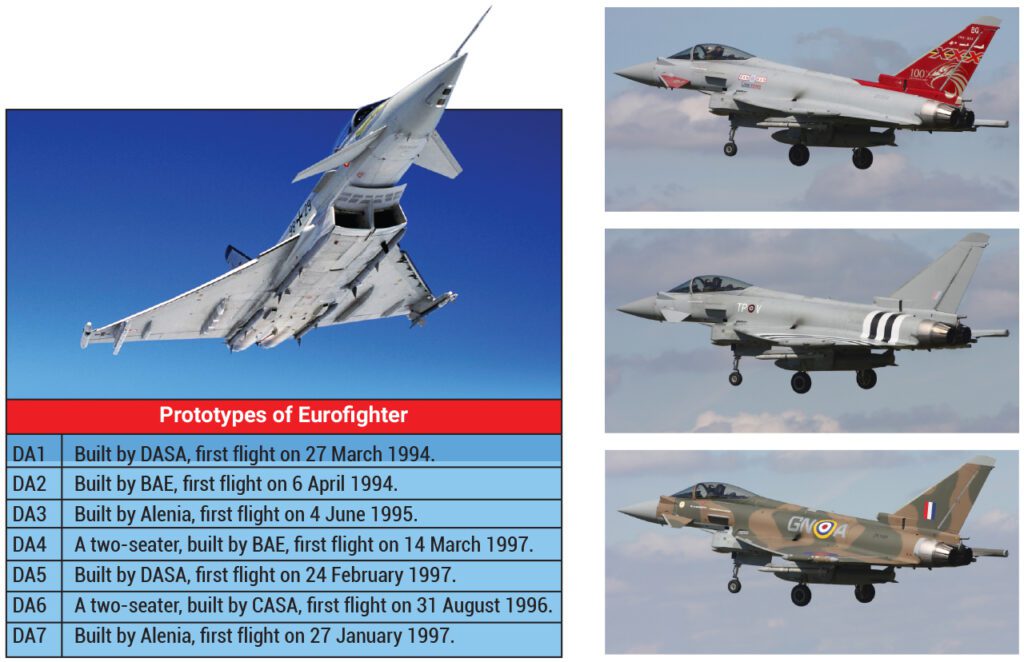
The construction of the first Eurofighter Typhoon prototypes began in 1989 and it was agreed that each of the four nations would have a production line to assemble their own aircraft but also the final assembly for components of the aircraft including export. Negotiations started and looking at the percentage of the amount of expected sales, Dasa (Deutshe Aerospace AG) was given 33%, British Aerospace 33%, Aeritalia 21% and CASA (ConstruccionesAeronauticas SA) 13%. The company Premium Aerotec to build the main centre fuselage, EADS Casa the right slat, BAE Systems the front hull, dorsal, tail-fin, inboard flaperons and rear hull section. Whereas Leonardo decided to produce left outboard flaperons and rear hull sections. Initially each participating country decided to order some number of aircraft; UK 232, Germany 180, Italy 121, and Spain 87 aircraft.
During 1990s, the participating countries had to make a selection for the Eurofighters radar. The UK, Italy and Spain supported the Ferranti Defence Systems, which is an English firm that offered the ECR-90 (European Collaborative Radar). This radar was based on the British build Blue Vixen airborne radar, designed and build for the Royal Navy and the Sea Harrier. Germany instead preferred the MSD2000 based on the APG-65 radar. The MSD2000 was a radar developed by the American company Hughes with support of West Germany AEG and GEC Marconi. Especially developed for the US Navy F-18 Hornet, it based on the AN/APG-65 fire control radar systems. Excessive cost was one of the reasons that Germany did not prefer the Ferranti radar.
Moreover, they were interested in using the Hughes radar to upgrade their F-4F Phantoms so that these aircraft could be equipped with the same weapons as the Eurofighter. Meanwhile the Ferranti Company had financial issues and the British government eventually supported the GEC Marconi Electronic Systems.
In 1994, the Chiefs’ of Air Staff of the four countries agreed on the advance requirements of the aircraft. This lead to the production of Eurofighter Typhoon DA (Development Aircraft) namely the DA1 and DA2. DA1 started flying in Germany and its main role was to evaluate handling characteristics and engine performance.The first flight took place on 27 March 1994 and it was flown by the DASA chief test pilot Peter Weger. The aircraft later got retired in December 2005. DA2 flew on 6 April 1994 in the United Kingdom for the first time. It undertook trials for flight control assessments and load bearing. The flight control assessments included the development of the Eurofighters “Carefree Handling” technique. The technique meant that the pilot has full liberty and could perform whatever action he wants with the control stick, rudders and throttle. Moreover, the basic purpose of these carefree trials was to evaluate the Flight Control System (FCS) on the aircraft. During these tests, the aircraft was fitted with the most demanding weapons configuration as well. The trials were needed to clear the Eurofighter Typhoon for the Initial Operational Clearance. The DA2 was the only Eurofighter that could undertake these Carefree Handling Trials. It continued to fly various trials until January 2007 after which it was retired and put on static display in the Royal Air Force museum in Hendon, London.
In 1997 the 500th test flight took place in Manching, Germany. During the late 1990’s and early 2000’s the Eurofighter Typhoon undertook extensive environmental, weapon firing, in flight fuelling and supersonic speed tests.
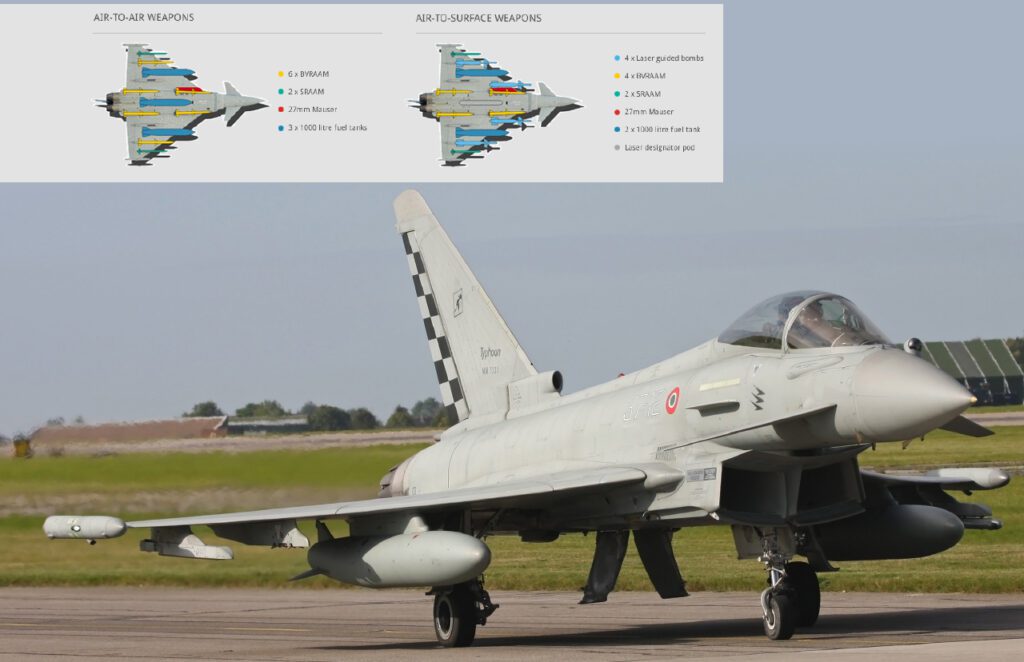
Eurofighter: The Capabilities
The Eurofighter Typhoon has evolved to be an extremely flexible and efficient multi-role aircraft. With an ability to carry an impressive arsenal of weapons, the Eurofighter-Typhoon can quickly sway over any given operation. One of the major advantages that the aircraft boasts is its well-designed architecture and construction, which provides ample room for upgradation and evolution. This ensures that the fighter will continue to be relevant and operational for a substantial number of years to come. Built from materials that maximizes stealth, and equipped with state-of-the-art sensors and weapons systems, make the Typhoon a formidable foe in both close range and BVR (Beyond Visual Range) combat environments.
The Airframe:
With carbon fibre composites at the helm, the Typhoon is built with modified materials that makes it hard to detect by radar. With veteran pilots a constant part of the process, the Eurofighter’s airframe has been paradoxically designed to be deliberately unstable while being easily manoeuvrable, even at supersonic speeds. Usage of the likes aluminium lithium, titanium and glass reinforced plastic has reduced the weight of the aircraft by 30% compared to conventional materials.
The Engine:
The Eurofighter has been fitted with a EJ2000 engine. It features a 2-spool design with single-stage turbines which runs the 3-stage fan and 5-stage HP compressor with annular combustion with vaporising burners. This gives the lightweight engine the thrust that the Typhoon needs while maintaining its high strength and high temperature tolerance. The engine can go without unscheduled maintenance for about a 1000 flying hours owing to its advanced integrated Health Monitoring.
The Sensors:
The Typhoon has been fitted with several high-tech sensors that perpetually scans the battle space and integrates it with data acquired to provide the pilot with actionable intelligence. The Typhoon features a Captor-M mechanically scanned radar and a Captor-E electronically scanned radar. The roomy aperture of the aircraft allows the placement of an array which has a field of regard 50% wider than traditional fixed-plate systems. This means that the Typhoon offers several superior features in both Air-to-Air and Air-to-Surface operations which includes:
The Cockpit:
As mentioned, the development of the Typhoon has always involved veteran pilots. This remains true for its upgradation, as well, with constant consultation from operational air force pilots who have been flying the Typhoon. The cockpit has been designed to optimize single-pilot operation. The upgrades have been made after a series of formal assessments in a rapid prototype facility. Installations such as the Direct Voice Input (DVI) and Hands-On Throttle And Stick (HOTAS) control functions have ensured that the Typhoon can function with a single pilot in the toughest of combat scenarios.
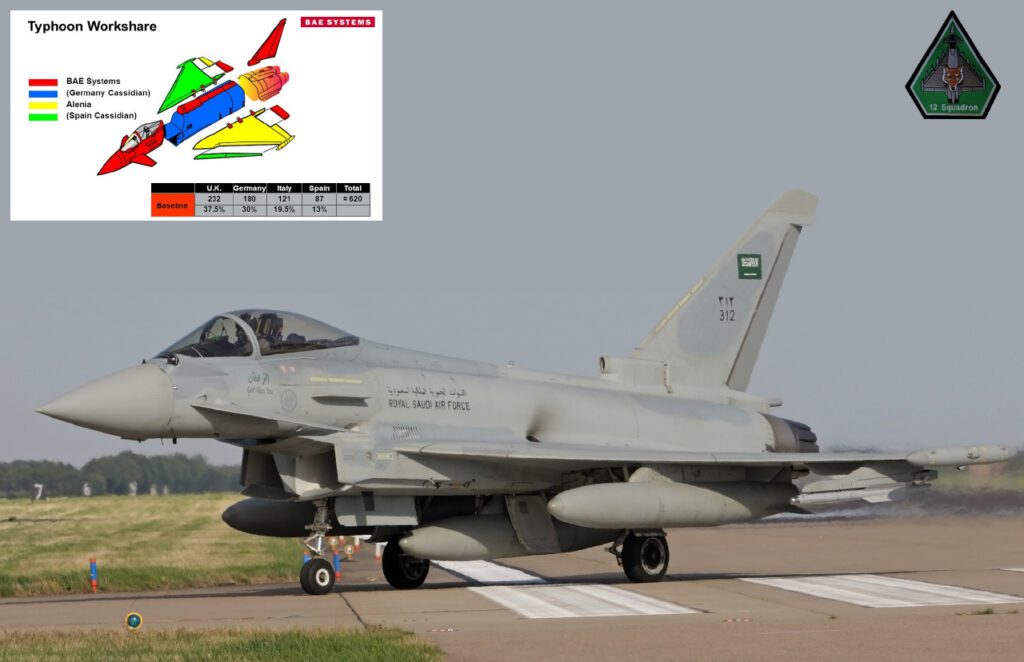
The cockpits Head Up Display (HUD) allows the pilot a stable, low-latency eyes-out guidance, which features night vision and laser protection goggles. The Multi-function Head Down Display (MHDD) is used for the bigger picture, presenting combat scenario and format, map displays and system status displays. The Typhoon also boasts a unique Helmet Mounted Symbology System (HMSS). HMSS provides the pilot with constantly updated flight and weapons aiming data through the visor. The helmet also features optics blast, upgraded oxygen mask, night vision enhancement camera and a head position tracking system. These displays also integrates the exchange of real-time data and flight information from the air force, naval, ground and any other relevant sources using the state-of-the-art Multifunctional Information Distribution System (MIDS).
The Typhoon also has several advanced systems and sensors for navigation and flight stability. The sensors fitted within the aircraft allows for covert operations as low as 100ft, with automation playing a heavy role. The usual Global Positioning System comes with a digital interface with individual satellite tracking channels and anti-jam capabilities. The plane also features a well-rounded inertial navigation system, allowing for 3D situational awareness at all times. Typhoon’s Flight Control System (FCS) is another complex and useful add-on which allows the pilot significantly better handling and free manoeuvring.
The Weapons Systems:
The Eurofighter Typhoon quickly dominates the battlefield with its impressive and versatile arsenal of weapons capabilities. From Beyond Visual Range (BVR) Air-to-Air technology, such as the METEOR advanced long-range missile to Short Range Air-to-Air Missiles (SRAAMs) and 27mm Mauser Cannon, the Typhoon always has something up its sleeve. When it comes to Air-to-Surface combat, the Laser Designator Pod (LDP) allows the Typhoon precise location of targets. It has been armed with Paveway IV and Brimstone to undertake a number of versatile operations effectively. The veteran dual-mode guidance system, complimented by height of burst and penetrating capability, enable the pilot to make decisions upto the moment of release.
The Flight of the Typhoon:
The Typhoon saw action in 2011 in Libya. The United Nations Security Council passed resolutions to protect Libyan citizens from Colonel Muhammad Qaddafi’s militia, which was fighting a rebel uprising. The UN forces were ordered to restrict themselves by not putting any troops on ground. Later the same year, Britain was part of a coalition of 11 NATO members who began an aerial campaign against Libyan military. The British effort was titled Operation Ellamy. 6 Typhoons were part of the 32 aircraft that flew to target Libyan targets. The Typhoon squadron were led by Wg Cdr Jez Attridge, a veteran who was an adept at flying Tornados, Typhoon’s predecessors.
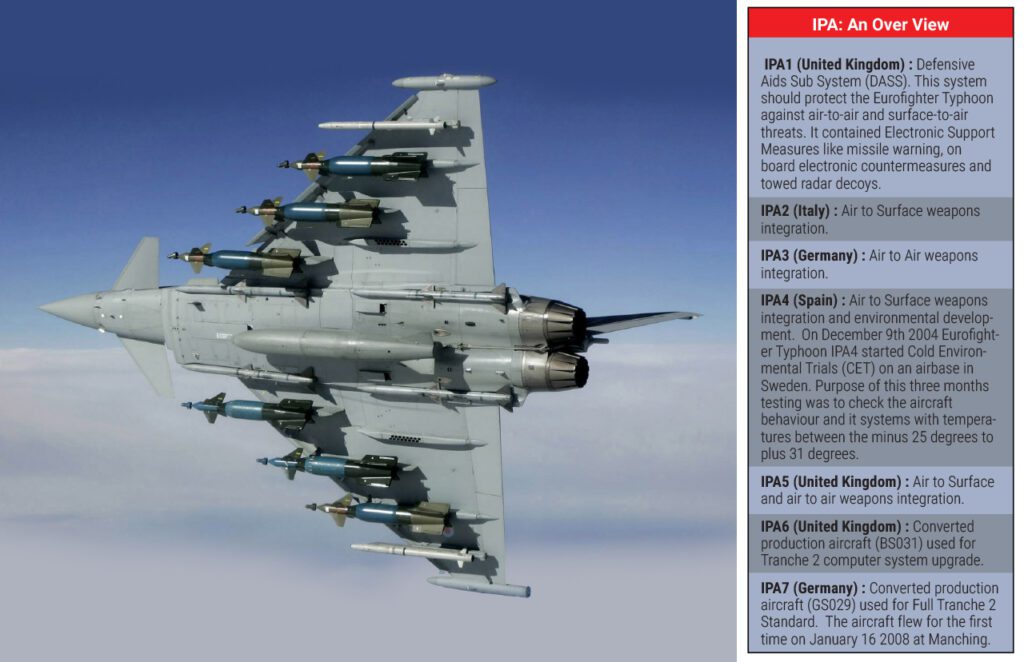
In an interview, Attridge explains how the Typhoons which were meant to fly out to Libya were converted from air superiority fighters to an aircraft which would specialize in engaging targets on the ground. The fact that an aircraft could be converted from one role to an entirely different one in a matter of days was impressive. “It went to multi-role in a weekend.” said Attridge, adding that the crew just had to make some software modifications in the cockpit displays. The Typhoons, currently, are being used in combinations with other fighters, usually the Tornadoes. The Tornados have been equipped with Paveway IV, also called Brimstone and the longer-range Storm Shadow, which can demolish anti-craft and bunkers from 100 miles away. As discussed before, the Eurofighter will soon be fitted with these weapons systems, with the addition of the Meteor, a BVR air-to-air missile which is being developed, and upgraded with laser and infrared targeting systems. “One Typhoon doing the same job as two aircraft, an air defence and an air-to-surface Tornado,” as Attridge explains it. “It’s the most capable aircraft we’ve ever had.”
Sales:
The Eurofighter is now in service with all four Eurofighter member nations. Each air force is obtaining aircraft from its local manufacturer. This statement, however, is a bit misleading. To be specific, the construction of sub-assemblies is parcelled out to each country, one after the other, essentially forming an assembly line of sorts between the countries. It was recognized early on that the erection of full manufacturing facilities in each partner nation would be excessively wasteful and tedious. So, factories in each Eurofighter member nation provide parts for a “kit”, in the form of major sub-assemblies; each factory then obtains all the sub-assemblies and fits them together. The sub-assemblies are designed in a modular fashion to ensure that they can be pieced together with relative ease.
Eurofighter-Typhoon Tranches:
The Typhoon was rolled out in segments or ‘Tranches’. Till date, the aircraft has 3 tranches. Each tranche has more capabilities than the last. Early Tranche 1 aircraft were intended for training purposes, which is usually the protocol. It did not feature datalinks or DASS and the weapons systems were also limited. Advanced Tranche 1 Typhoons had upgraded air-to-air combat capabilities, capable of supporting AAMs the likes of AIM-9L Sidewinder, the ASRAAM, and the AIM-120B AMRAAM. This tranche also featured limited air-to-ground capabilities.
Early Tranche 2 planes rolled out in 2008. It had superior air-to-air capabilities. Later Tranche 2 Typhoons were finalized in 2010 and had both air-to-air and air-to-ground capabilities, making it a formidable multi-role aircraft.
Tranche 3A is still being delivered. It integrates advanced weapons systems such as Meteor BVRAAM, the Storm Shadow standoff missile, and the SPEAR series of air-to-ground munitions. It also includes improvements on the radar, engine and fuel tanks.
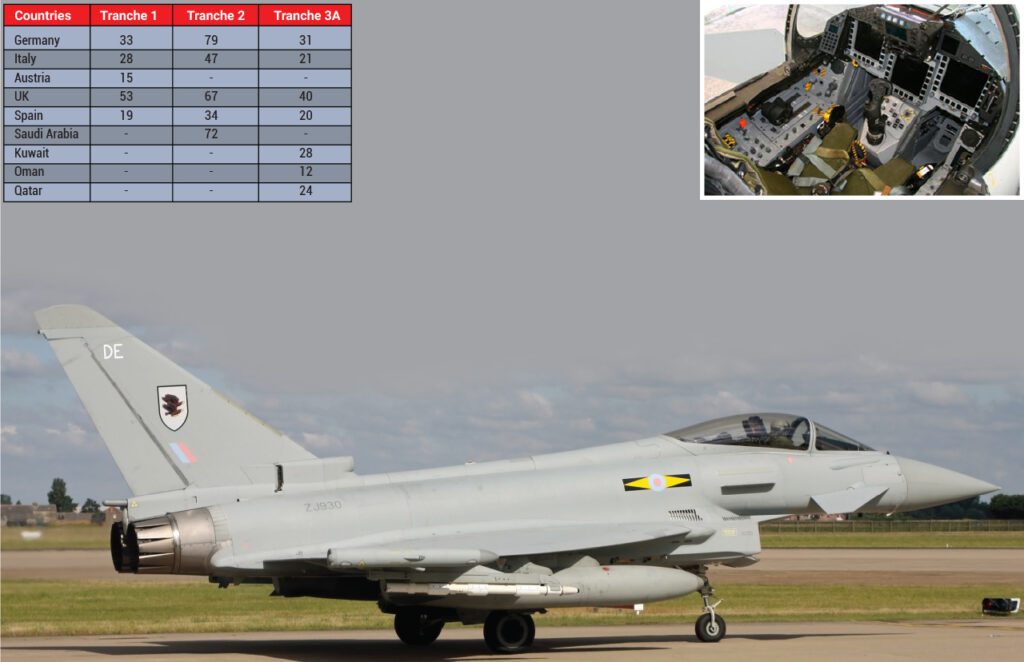
A Tranche 3B was originally planned but was effectively abandoned later on. In 2019, a “Long-Term Evolution (LTE)” plan was announced. It will include studies to improve mission system architecture, defensive aids, the human-machine interface (HMI), operational flexibility, and engine performance. An Eurofighter official commented “The LTE will support the generation, transmission, and utilization of increasing amounts of digital data both on board (via advanced multispectral sensors) and off board (via high-performance tactical datalinks), whilst countering new and emerging threats, including cyber. This will maintain the Eurofighter’s ability to operate in the highly contested and congested future operating environment.”
One of the countries that is also flying the Eurofighter Typhoon is Austria. They fly with fifteen Typhoons all with the Tranche 1 standard. Austria is already looking to replace these aircraft which they bought in 2003. They would like to replace them with an aircraft that is cheaper to operate.
On 18 November 2020, the Eurofighter company officially offered the Typhoon to Switzerland which is looking for an replacement of the aging F-5E/F. If the Swiss government decides to choose the Typhoon, Germany will be interested in improved joint training. Meanwhile the Germans signed a new contract for 38 Typhoons with the latest Tranche 4 Standard.
Although, details have not been announced, there is no doubt that the upgraded version of Eurofighter-Typhoon will continue to evolve and play a significant role in aerial warfare in the decades to come.
